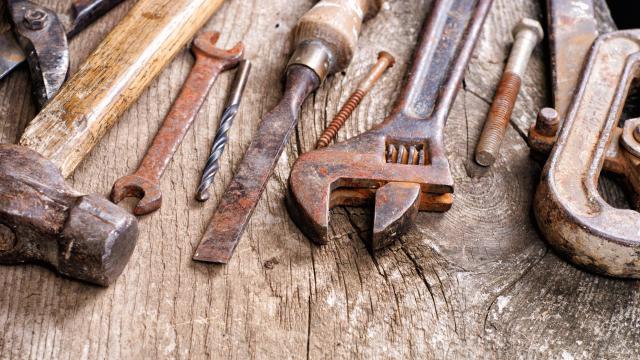Whether you inherited them from your parents or grandparents, or got them for a great price at a yard sale or flea market, you may have some rusty tools sitting around your home, basement, or garage right now. And maybe one day, you need a wrench, or hammer, or garden trowel, reach for one of these rust-covered tools, and realise that it’s time to get them back in working order.
Fortunately, there are several methods for doing that, as well as ways to keep rust at bay moving forward. Here’s what to know.
How to remove rust from tools
There are a few different ways to remove rust — some of which require more elbow grease than others. (Of course, that also depends on how much rust your tools have accumulated over time.) Here are some options.
Wash and sand
First, wash the tools in a tub of warm water with dish soap, making sure to wipe away any grease and dirt. Rinse and thoroughly dry the tools. Then, depending on the extent of the rust, use a scouring pad, steel wool, sandpaper, or a wire brush to remove as much of the rust as possible.
Give it a soak
Again, start by washing your tools in warm, soapy water to remove grease and loose dirt and debris. Then, get a bucket or basin large enough to fit your tools. Pop the tools in the bucket, and then pour enough of one of these liquids over them until they’re fully submerged.
- White vinegar: Let the tools soak overnight or as long as 24 hours. You may need to use a wire brush or sandpaper to get the last remaining rust, but it should come off relatively easily.
- Citric acid: For every gallon of hot water in the bucket, add 1/3 cup of citric acid. Mix the solution well, then add the tools and make sure they’re fully covered. Some tools will be ready in a few hours; others will have to soak overnight.
- Oxalic acid: For every gallon of water, add three tablespoons of oxalic acid. Add and submerge the tools. Check them after 20 minutes. Leave them in a big longer if they aren’t quite there yet.
After the tools are finished with their acid baths, rinse them off with clean water, and thoroughly dry them.
How to prevent new rust from forming
Once your tools are rust-free (or close to it), double check that they’re completely dry. Then spray or wipe on a small amount of multipurpose oil, like WD-40, mineral oil, boiled linseed oil, to seal the tool. For extra protection, spray on a layer of lacquer or clear coat.
Moving forward, be sure to store your tools somewhere as dry as possible. And keep it clean: Dust attracts moisture.

Leave a Reply
You must be logged in to post a comment.